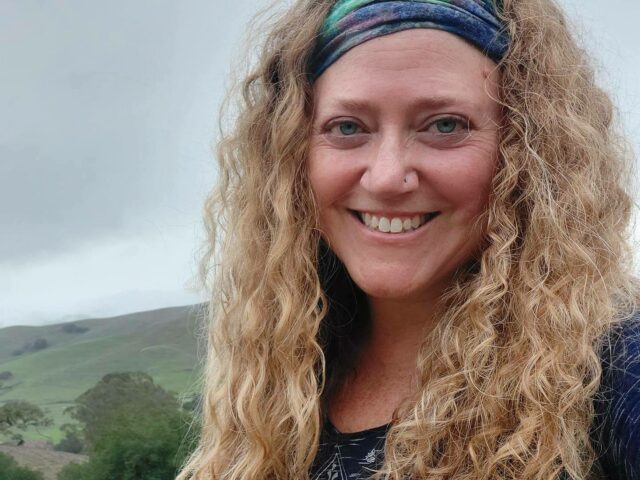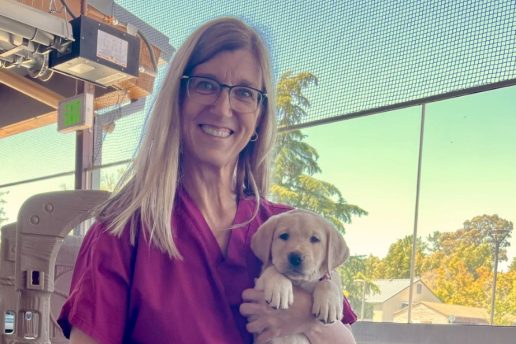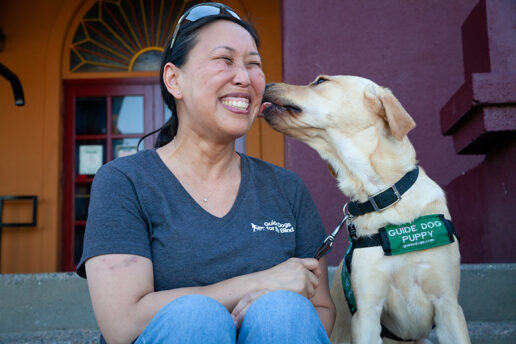
Central Bark Episode 7
National Volunteer Month at GDB
April is National Volunteer Month and here at Guide Dogs for the Blind, we could not do what we do without the support and the dedication of our amazing volunteers. In the last 80 years, volunteers have given more than 1,000,000 hours of their time to support our life-changing mission.
This week, Theresa interviews our Volunteer Engagement Manager, Jen Bernstein about the community of volunteers that make our work possible.
For more information about volunteering with Guide Dogs for the Blind, visit guidedogs.com/volunteer.
Theresa. Stern: Well, hello, everyone, and welcome to Central Bark, a podcast from Guide Dogs for the Blind. Super excited to be with you all today. We have a really amazing guest, one of our staff members who does a really, really important job here at Guide Dogs for the Blind. She is our Manager of Volunteers and her name is Jennifer Bernstein. Jennifer say hi to everyone.
Jennifer Bernstein: Hi, everybody. I'm here.
Theresa: She is. She is. And actually, Jen, you've been here a long time. How many years have you been working at Guide Dogs?
Jennifer: July of this year will be 21 years, so it's been a while, yeah.
Theresa: Oh, that is fantastic. That's some serious dedication. We really appreciate you.
Jennifer: There's nowhere else I'd rather be.
Theresa: Oh, good. So tell me a little bit about how you came across Guide Dogs for the Blind.
Jennifer: This is a true story, so when I first moved up to Marin, 21 or 23 years ago, now I had a job outside of the nonprofit world and was part of a reduction in workforce and I needed to be working at that time, that wasn't a time to be off work, and back then, we had employment agencies, which may be new for younger listeners, but I went in and that day, after I cleaned out my desk, I walked into an employment agency and said, "I can't be out of work right now."
And I had worked at the Santa Cruz SPCA back in the day, I was the Client Services Manager there, so when I came back into the employment agency and said, "I'd love to be back in nonprofit. I would love to work maybe with animals again, but I don't think I want to do a shelter, maybe volunteers this time." And that day, they handed me this job, basically, so I like to tell people I actually asked for this job specifically, and three weeks later I was doing this job, so...
Theresa: Wow.
Jennifer: Yeah. [crosstalk 00:02:05]...
Theresa: That is definitely serendipity, right? Right there.
Jennifer: [crosstalk 00:02:08] meant to be. Exactly. So, yeah.
Theresa: Amazing. Amazing. That's so cool. And tell me a little bit about working at Guide Dogs for the Blind. I mean, I know we have all our volunteer puppy raisers and things who do so much for us, but you are really kind of working with our campus volunteers and people who sort of volunteer in other capacities here at Guide Dogs. Can you tell me a little bit about the impact that our volunteers make and a little bit about your program?
Jennifer: Absolutely, so it's important to really know that volunteers are pretty well-engaged in every department in some way or another on both campuses, so some of maybe the more obvious are some of the dog care positions, for instance, when we opened the brand new puppy center in California, there were a number of support positions that came there, that which include brood socialization and dog-walking and things to do with the puppies directly.
And then there are a large number of things that support other parts of the organization, so we have folks who prepare meals for the dogs, people who bathe the dogs, but also folks who work directly with clients, either driving or serving meals while students are in class or helping folks get oriented to their room, and that's on both campuses, we have folks who drive, a lot of driving for people, either picking up, taking back to the airport, taking dogs to appointments, taking staff who are blind or visually impaired to speaking events, or just really supporting in that way too, and that is a big need. We have folks who help out in the gift shop and we have folks who help out in the administrative ways, accounting and in those kinds of departments and putting together sort of the more typical vision of office volunteering packets than doing things like that.
And I really have to shoutout to my team, Rita Lockett and Bonnie Shoffner. The three of us really pride ourselves on being able to make nice matches with people. We try to find out why a person has come to volunteer with us and what they're interested in, what their schedule allows for, and really try to find something that's going to feel very meaningful and resonant to what they want to do for us, because we're so grateful they've come.
Theresa: Yeah, no, and I think that's just... It's really so cool, I guess, if I can't think of a better word to say, but it's really awesome that there's so many different ways that volunteers can interact with our mission, like you were saying, so the dog piece, puppies to older, senior dogs and then working directly with clients, which is great.
Personally, as a blind staff member, I have been so thrilled to have wonderful volunteer drivers who've taken me to my speaking engagements or to the airport when I had to travel and that kind of thing, and that's just been really, really fun, and I know our students, they love meeting the volunteers and the volunteers will pick up the students from the airport where they're first coming to get their guide dog and then take those same students back a couple weeks later to the airport and get to hear the whole story and get to see the whole mission all come together too, and like you said, working in the student residence, doing meals and then helping in the gift shop and all... So it's just, I love that there's so many ways, I guess, that people can, like I said, have these sort of touch points with what we do here at Guide Dogs for the Blind.
Jennifer: Absolutely, and I would be remiss to not mention our Foster Care families at this point, too.
Theresa: Oh, my gosh. Yes.
Jennifer: Foster Care are this incredible community of volunteers who take dogs into their homes for a wide variety of reasons. These are folks who are so giving and so generous of their time and their resources, we really lean very heavily on them on both campuses, and some of them even take the dogs back and forth from campus every day to try and accommodate what specific dogs might need to be successful, so big shoutout to the Foster Care community as well.
Theresa: Absolutely. Absolutely. Yes. Yes. They definitely come in and provide that nice home for whichever dogs need some foster care and yeah, no, I think that's just a really great way to contribute to Guide Dogs for the Blind. So for people that are interested in volunteering, how do they go about that? And then how do you do the matching and stuff? It's really interesting to me.
Jennifer: Sure. So people reach out to us on the website for the most part, so that's guidedogs.com. The minimum age is 18, so someone is 18 years of age or older, they let us know. They let me know they're interested, typically, and I'll send them a list of what's available and they can decide if there's a match now or if there's something we'll talk about in the future, then usually we'll sit down and talk with each other. Thank goodness for Zoom, right? Now I can Zoom with them and get to know them that way a little bit. Bonnie does the same thing on the Oregon campus. And again, we're chatting with them to find out what are they interested in volunteering to do? What are their skills? What's their schedule?
And one of the questions that I think we ask that tends to throw people is, "What do you hope to take away from volunteering?" And I think sometimes people forget that it's more than okay, it's important to want something back and that it's okay for that to be a process of reciprocity, that while they are providing this wonderful service for us, hopefully, in return, we're thanking them in the way that feels best for them as well, so recognition is a really large part of what we do and we want to make sure people feel recognized and that's a little bit of a nuanced process too, that requires knowing someone and knowing what's meaningful and really trying to make sure that they feel thanked in a way that means the most to them.
Theresa: Yeah. I think one of the things that I love that I think you've really brought to Guide Dogs for the Blind here, Jen, is our volunteers really have kind of... They're a community. They care about each other. Some of them have been coming for years and years and years. Do you have some examples of some of our long-term volunteers?
Jennifer: I know we have at least a few 40-year celebrants this year.
Theresa: Wow.
Jennifer: Definitely have some 20s, for sure, and probably some in between, but it is not uncommon at all for a person to come in and stay for that 20, 30, 40 year. We've had a couple 50s over the years, which is really exciting too, and we certainly try to fuss over them, but, you know, I'll fuss over one year too. I always think that the longevity is always amazing and for the person, let's say, who's a full-time employee of somewhere else, they're working, they have very limited time, I'm grateful for those two hours that they can give me too. I'm always really grateful and try to stay aware of when people are... Whatever time they're able to give us, I'm genuinely grateful for that on whatever scale is easy for or available to them.
This is a very robust group of people. These are folks who have had very robust professional lives, folks who come to us from all different places, all different personal stories. The one thing they've had in common, a lot of the time, they either saw us on the streets, they've seen us growing up. I cannot tell you how many times somebody has said, "I saw you when I was a child and I knew I had to get involved as soon as possible." And sometimes that's 40, 50 years later, but they remembered us, and as soon as they actually had that kind of time in their lives, they stuck to their own commitment to themselves that they were going to come contribute to us even all those years later and I'm always really impressed by that.
Theresa: Yeah. Yeah. Now tell me a little bit, this last two years has been super crazy, right? With the pandemic? Tell me a little bit about how volunteering worked during that time and how you kept that sort of sense of community amongst your volunteers.
Jennifer: Well, I have to say, in the 20 years of being a Volunteer Manager, I never anticipated having to say to my volunteers, "Stay home. Don't come." That was very bizarre, and I think it was as bizarre for them as it was for me, and these folks, so remarkably, stood by us, waited for the green light and said, "All right, if I can't come do my usual job, how can I help? What can I do?" Showed up immediately. And one of the first things they did was made masks even before we...
Theresa: Oh, gosh, you're right. Oh, you're making me cry.
Jennifer: Before we could buy masks, before we even really knew what that meant or why we were wearing them or whatever, we found out we needed to start wearing masks and I really think they tore up their bedsheets. I think they really did use things they had at home, they just knew we needed them and we even said, "We can't even say hi to you on campus right now." So they dropped them off in different barrels, drove onto campus and drove off, on both campuses, and delivered hundreds, maybe thousands, but certainly hundreds of masks that got used.
Theresa: Yes, they did.
Jennifer: And we're all accustomed to the very sort of sterile and standard ones right now, but back then, they were all a little unique. They were all made of all sorts of materials, and I think that made them, in a rather sort of frightening and uncertain time, that was a really special and meaningful thing, for staff to be able to say, "Oh, I've got this handmade mask with this really cute pattern." Or whatever. I think people started to have favorites too, but I don't remember [crosstalk 00:11:34].
Theresa: Yeah, no, you're right. It was very comforting and it's making me kind of tear up now just thinking about it, because it was just super selfless and it was like, I think you put out an email, and they were like... They had them done the next day.
Jennifer: Next day. And there was a moment where we had to say, "We are good. Thank you." Yeah.
Theresa: Oh, my goodness. That's so amazing. And then just, I think I'm just going to call you out a little, Jennifer, because I have you here. One of the things, because I've known you for a lot of years, we've both worked here a long time, and one of the things that has always sort of impressed me about you or has made an impact on me, is that not only are you managing this volunteer program, which is exceptional, here at Guide Dogs for the Blind, but you also believe in volunteering.
Jennifer: For me as a volunteer, I get to go and remember how good that feels and how amazing it is. My contribution is small, I have to admit, but even my small contribution is appreciated, the folks there are terrific at that, and that sense, again, of if they asked me, "So, what do you hope to take away from volunteering?" That it's important for me to have an answer to that question, just as I ask that question of my own volunteers. It's okay for us to want something in return. It's okay for us to do it because it makes us feel good or because we want to support the organization or maybe it touches something personal. All of those, and all the other ones too, are good reasons to volunteer, so there's really no downside.
Theresa: That's fantastic. I just... I do think that that really shows in the program that you've created here is your own dedication to volunteerism.
Jennifer: Think so. I hope so. Thank you.
Theresa: Yeah, absolutely.
Jennifer: You know, Theresa, it's important, probably, for me to point out that there are several ways to volunteer and if a person is interested, my program is specific to folks that want to work on one of the two campuses or want to provide foster care. And then, while they're on the website, they also can look into raising a puppy, which is a separate program, but another extraordinary group of individuals and all of that information is available on the website as well.
And then in California, to explore being a breeder custodian is yet another way to volunteer, which is providing housing for one of our wonderful breeding stock dogs, which I actually also did as a volunteer myself. I was a breeder custodian for a male and a female, and so yeah, there's actually quite a lot of ways to volunteer and it's really extraordinary how many different ways individuals will support us, through different modes of volunteering, through donations, through becoming employees, sometimes, if that's what their path leads them to, to all different ways, telling their friends about us and just sharing our story in whatever way makes the most sense for them.
Theresa: That's great. That's great. Yes. So everyone, if you want to kind of spice up your life a little bit and have the opportunity to contribute to the Guide Dogs for the Blind mission, certainly encourage you to check out our volunteer program and you can do that, I believe, Jen, by just going to guidedogs.com...
Jennifer: Click on "Volunteer".
Theresa: ... and click on "Volunteering" and we'll get you set up, so thank you so much, Jennifer. Thank you so much for everything you do for Guide Dogs for the Blind and thanks for being here today.
Jennifer: Oh, thank you, Theresa, thanks for having me and thank you for everything that you do.
Theresa: For more information about Guide Dogs for the Blind, please visit guidedogs.com.
Related Episodes


